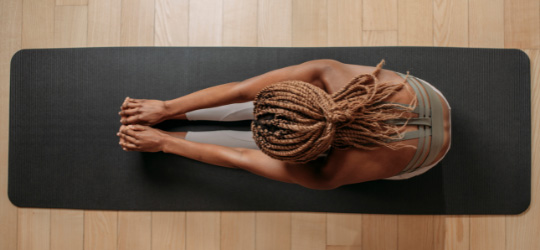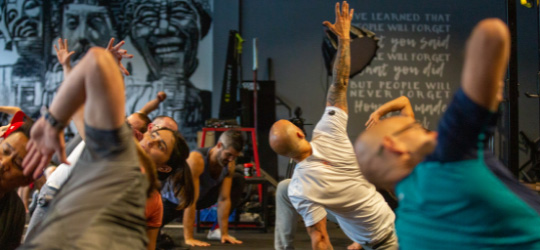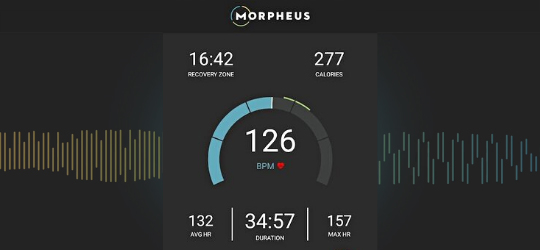There are many ways to try and speed up recovery these days, from massage and soft tissue work, to hydrotherapy, meditation, and more.
One thing people almost never consider as a potential recovery tool, however, is a workout.
That’s because when it comes to training, most people think of high intensity, fatigue, and soreness. Working out is a way to get stronger, leaner, faster, etc., but not to recover.
But what if there’s a way to use a workout to get better by speeding up recovery rather than putting the body under more stress?

The story of Rebound Training
The idea of using training to speed up recovery came from two things:
- Years of working with combat athletes who were doing strength and conditioning in the morning and skill training in the evening. I needed to train them in the morning without leaving them too fatigued to perform their second workout.
- Research done by the military on elite special forces units that measured changes in HRV during periods of extremely stressful training. They found that people whose HRV went up as soon as the stress was over, indicating a shift towards recovery, were the ones who were able to make it through training.
Over time, I experimented with a wide variety of training methods to try and speed up recovery. With enough trial, error and data analysis, I eventually came up with a specific workout strategy that I called Rebound Training.
When it’s incorporated into a weekly training program, Rebound Training has a ton of benefits. It:
- Helps shift the body into a “recovery state” where the body becomes more parasympathetic and HRV is driven up.
- Stimulates blood flow into every muscle fiber without providing too much additional stress that’ll slow recovery down rather than speed it up.
- Develops the metabolic systems that drive recovery — so that someone’s overall ability to tolerate and handle the stress of life improves.
- Improves breathing and movement quality in a way that can reduce joint stress and help avoid unnecessary increases in stress hormones.
- Doesn’t take too much time. Working on recovery shouldn’t be boring or take as long as a normal workout. I designed the workouts to be no more than 30-45 minutes.
- Makes you feel better. After a Rebound Training session, you should leave the gym feeling better than when you walked in.
Rebound Training with Morpheus
One of the great things about recovery workouts is that there are virtually endless ways to do them. They are also convenient because they don’t take much time and they don’t require any sort of specialized equipment.
The key is to just follow three basic principles:
- Keep the workout short. No more than 45 minutes. I’ve found that 25-35 total minutes from start to finish tends to be the sweet spot for most people
- Stay in the blue zone.The blue zone in Morpheus is called the recovery zone for a reason. This is the right level of intensity to promote recovery, so you’ll want the majority of the workout to be in the blue. You’ll also need to keep your average heart rate over 100bpm. Going for a walk can be good for staying active and will increase your step count, but a recovery workout is about more than just taking steps.
- Use a variety of movements. In order to drive blood flow into as many muscle groups as possible, it’s beneficial to include a variety of movement patterns.
If you have an area that’s particularly sore from a previous workout, spend extra time doing exercises using those muscles to drive blood flow into them and promote recovery.
Rebound Training Template
As long as you follow the principles above, you’ll be on the right track to speed up your recovery in between your more intense training sessions. To make it easier to be consistent and to make the workouts as effective as possible, I typically use a template with the same four components:
Breathe and mobilize (5 min)
I like to start most workouts with a few minutes of breathing drills and mobility exercises. These can help develop and reinforce healthier breathing patterns while supporting better mobility.
There is a wide variety of types of breathing you can do, but if you’re just starting out and want an easy one, give box breathing a try.
To do it, inhale slowly through the nose for 4-5 seconds. Next, hold your breath for 4-5 seconds before exhaling through your mouth for 4-5 seconds. Finish that cycle with another breath hold for 4-5 seconds before repeating.
After a minute or two of doing breathwork, move on to 2-3 of your favorite mobility drills to finish the warm up.
Recovery zone training (15-20 min)
After the warm up, it’s time to get in the blue zone and ramp your heart rate up. There are a couple of ways you can do this.
The first is simply doing a circuit of a few different exercises. I like to use 3-5 exercises for 60-90 seconds each while keeping heart rates relatively constant when moving from one exercise to another.
The second method is doing what I call high/low intervals in the blue zone.
Here, you’ll keep your heart rate in the middle of the blue for 60 seconds, then drive it up to the top of the blue for 60 seconds, and repeat.
You can choose to switch exercises after each round, or you can do a few rounds in a row with one exercise before moving on. It’s generally valuable to incorporate 3-5 different exercises into the recovery zone training time.
This will help drive blood flow to as many different muscles and tissues as possible.
Strength stimulation (5-10 min)
Once you’ve finished your time in the recovery zone, adding in a couple of strength exercises is optional, but it can help drive blood flow into the bigger, stronger, fast-twitch muscle fibers.
These fibers normally don’t get worked much at lower intensities.
The key is to keep the volume low. No more than 2-3 working sets of a single total body exercise like deadlifts, squats, or even explosive movements like box jumps.
If you don’t have any equipment, exercises like bodyweight jump squats and explosive push ups can do the trick.
You can do the strength exercises at higher intensities, but keep the volume limited to no more than 8-10 total reps across the 2-3 sets. This will ensure you speed up recovery instead of slow it down.
4. Recovery cool-down (3-5 min)
The last and final component of a recovery workout is spending a few minutes driving your heart rate as low as possible. Your goal should be to get it within 5-10 bpm of your morning resting HR as quickly as possible.
The easiest way to do this is to lay on the ground and focus on breathing and relaxing. The more you practice dropping your heart rate quickly, the better you’ll get at it.
Once your heart rate is down, finish off with any type of soft tissue work that you enjoy. There are a huge variety of tools available today that can be used for this purpose. The end of a recovery workout is a great time to use them.
Earning points with recovery workouts
Throughout the challenge, you can earn points for up to 3 recovery workouts per week. You’ll get a baseline of 10 points for completing the workout, plus bonus points based on how much your recovery score increases in Morpheus as a result.
If you follow the guidelines above, you should see your recovery score increase 3-5% on average. This lets you know that you’ve spent the right amount of time at the right intensity to speed up recovery.
If you see a smaller increase, or none at all, it means you probably went too hard and/or trained for too long.
Remember, everything comes down to energy. If you end up burning too many calories or adding too much stress, it defeats the purpose of doing a recovery workout.
When it comes to recovery, less is often more.

Action step
As a general rule of thumb, I encourage you to do one recovery workout 12-24 hours after every high intensity workout.
Doing this consistently can make a huge difference in the results you see and your ability to continue training hard without hitting plateaus or risking injury.
Over the weekend, get in at least 1 recovery workout. If you’re on IG, make sure to share the workout and tag Morpheus when your recovery score goes up! @trainwithmorpheus

